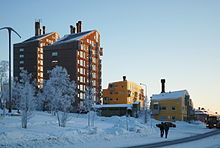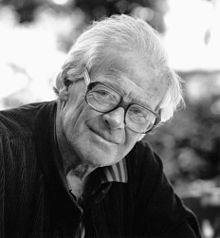Ralph Erskine (architect)
Ralph Erskine (born February 24, 1914 in Mill Hill / London , Great Britain ; † March 16, 2005 in Lovön, Ekerö municipality , Sweden ) was a British-Swedish architect .
education




After studying at Regent Street Polytechnic in London, Ralph Erskine came to Sweden via Denmark in 1939 , “with a bike, backpack and sleeping bag” (The Times). Attracted by the information of good friends that Sweden needed trained architects and the flourishing functionalism in the country, he settled near Stockholm. On August 29, 1939, he married Ruth Francis, who had come from England. Two days later the Second World War broke out and for the pacifist Erskine it was certainly a contributing reason to stay in neutral Sweden.
Lådan
His first own apartment was a typical Erskine design. With minimal means, he built during the Cold War Winter 1941-1942 south of Stockholm, in the middle of untouched nature, only 20 m for himself and his family two large houses, called Ladan (the box). The small living space was optimally used, however, the parents' bed could be pulled up to the ceiling and Erskine's drawing table could be folded up against the wall. There was no electricity or running water, but there was an herb garden, six beehives and a dovecote. Ralph Erskine spent four years here with his wife Ruth, two daughters and a couple of cats. Lådan fell into disrepair, but was rebuilt on Ekerö in 1989 and is now looked after and shown by the Architecture Museum.
plant
Erskine found his first job in the field of architecture in 1937-39 with the garden city architect Louis de Soissons . In 1944/45 he continued his studies at the Royal Art Academy in Stockholm. From 1942 he worked with the Dane Aage Rosenvold .
The former Quaker student remained connected to the country until the end of his life. Much of his work was created here. The then progressive social policy of the Scandinavian country opened up a wide range of possibilities for Erskine's architectural ideas. Dwellings, factories and urban planning for new parts of the city emerged, including the settlements Storvik and Gästrike-Hammarby (1947–1948), Sandviken (1951) and Avesta (1950–53). In 1963 his own home in Drottningholm was completed, Villa Erskine , with an associated architecture office.
At the end of the sixties he received construction and planning contracts in Great Britain. He realized a post-graduate college here in Cambridge (1967) and the pioneering Byker housing estate near Newcastle upon Tyne (1969), which Erskine also made internationally known.
Erskine's newer buildings include the Stockholm University Library (1983), the Gothenburg Skanskaskrapan (1989), the Stockholm World Trade Center (1989), the “Ark” office building in London (1991) and the Millennium Village in Greenwich (since 1998). Ralph Erskine, who has also worked as a university lecturer, received an honorary doctorate from Lund University in 1975 and the RIBA gold medal in 1987 . The Nordic Found donates the Ruth and Ralph Erskine Prize for social and ecological innovations every two years . Erskine was an honorary member of the Association of German Architects .
buildings
- around 1940: Villa and ski hut in Lissma
- 1941–1952: Erskine House in Lissma
- 1945–1955: District in Gyttorp, Nora
- 1947–1948: Nilsson house in Storrik
- 1947–1948: weaving mill in Köping
- from 1947: settlement for Kopparfors in Gästrike-Hammarby
- 1948: Tourist hotel in Borgafjäll
- 1950–1953: Settlement in Fors
- 1951: Kopparfors settlement in Jädraas
- 1954: Villa Tesdorpf in Skövde
- 1954: Luleå shopping center
- 1955–1956: House in Lisö near Stockholm
- 1950–1955: Cardboard factory in Fors
- 1961–1962: Kvarteret Ortdrivaren in Kiruna
- 1961: House Ström in Stocksund
- 1961: Gadelius house in Lidingö
- 1960–1968: Brittgarden city quarter in Tibro
- 1962–1968: "The Barber" district in Sandviken
- 1963 Villa Erskine on Lovön, Ekerö municipality
- 1969–1970: Esperanza urban district in Landskrona
- 1969–1981: Byker district in Newcastle, England
- 1969: Bread factory in Malmö
- 1970–1976: Studland Park Settlement in Newmarket , England
- 1973: Resolute Bay in Canada
- 1977–85: Myrstuguberget in Vårby, Huddinge
- 1979–1983: Stockholm University Library
- 1981: Allhuset for the Stockholm University Frescati
- 1984: Wasa Terminal in Stockholm
- 1991: Juristernas hus for Stockholm University
- 1997: Aula Magna of Stockholm University
- 1986–89: Skanskaskrapan , also known as Läppstiftet (lipstick), in the Lilla Bommen harbor area in Gothenburg
literature
- Ralph Erskine, arkitekt , Byggförlaget, Stockholm 1988
- Mats Egelius: Ways of a Builder . In German construction newspaper . Issue 3/1983
Web links
- Literature by and about Ralph Erskine in the catalog of the German National Library
- Website Erskine Tovatt Arkitekter AB (en / se)
- Detailed biography (s)
Individual evidence
| personal data | |
|---|---|
| SURNAME | Erskine, Ralph |
| BRIEF DESCRIPTION | British-Swedish architect |
| DATE OF BIRTH | February 24, 1914 |
| PLACE OF BIRTH | London |
| DATE OF DEATH | March 16, 2005 |
| Place of death | Ekerö (municipality) , Sweden |


